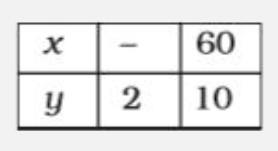Suppose y is equal to the sum of two quantities of which one varies directly as x and the other inversely as x. If when , and when , then what is the relation between x and y?
To solve the problem step by step, we need to find the relationship between x and y given that y is the sum of two quantities: one that varies directly as x and the other that varies inversely as x.
Step 1: Define the relationship
Let:
- The quantity that varies directly as x be kx (where k is a constant).
- The quantity that varies inversely as x be mx (where m is another constant).
Thus, we can express y as:
y=kx+mx
Step 2: Use the first condition
We know that y=6 when x=4. Substituting these values into the equation gives:
6=k(4)+m4
This simplifies to:
6=4k+m4
Multiplying through by 4 to eliminate the fraction:
24=16k+m(Equation 1)
Step 3: Use the second condition
Next, we know that y=103 when x=3. Substituting these values into the equation gives:
103=k(3)+m3
This simplifies to:
103=3k+m3
Multiplying through by 3 to eliminate the fraction:
10=9k+m(Equation 2)
Step 4: Solve the system of equations
Now we have a system of two equations:
1. 16k+m=24
2. 9k+m=10
We can eliminate m by subtracting Equation 2 from Equation 1:
(16k+m)−(9k+m)=24−10
This simplifies to:
7k=14
Thus, we find:
k=2
Step 5: Substitute k back to find m
Now we substitute k=2 back into one of the equations to find m. Using Equation 2:
9(2)+m=10
This simplifies to:
18+m=10
Thus, we find:
m=10−18=−8
Step 6: Write the final relationship
Now we have both constants:
- k=2
- m=−8
Substituting these values back into the equation for y:
y=2x−8x
Conclusion
The relationship between x and y is:
y=2x−8x
Let:
- The quantity that varies directly as x be kx (where k is a constant).
- The quantity that varies inversely as x be mx (where m is another constant).
y=kx+mx
We know that y=6 when x=4. Substituting these values into the equation gives:
6=k(4)+m4
This simplifies to:
6=4k+m4
Multiplying through by 4 to eliminate the fraction:
24=16k+m(Equation 1)
Next, we know that y=103 when x=3. Substituting these values into the equation gives:
103=k(3)+m3
This simplifies to:
103=3k+m3
Multiplying through by 3 to eliminate the fraction:
10=9k+m(Equation 2)
Now we have a system of two equations:
1. 16k+m=24
2. 9k+m=10
(16k+m)−(9k+m)=24−10
This simplifies to:
7k=14
Thus, we find:
k=2
Now we substitute k=2 back into one of the equations to find m. Using Equation 2:
9(2)+m=10
This simplifies to:
18+m=10
Thus, we find:
m=10−18=−8
Now we have both constants:
- k=2
- m=−8
y=2x−8x
The relationship between x and y is:
y=2x−8x
Similar Questions
Knowledge Check
Suppose y varies as the sum of two quantities of which one vasries directly as x and the other inversely as x. If y=6 when x=4 and y=313 when x=3 then the relation between x and y
Ax=y+4By=2x+8xC7=2x−8xDy=2x−4xIf x16=y23, then relation between x and y is
Ax=y2Bx=y4Cx4=yDx3=y8x varies directly as y and x varies inversely as the square of z. When y=75 and x=6, then z=5. Find the value of x when y=24 and z=4
A1B2C3D4
If x varies inversely as y and y = 60 when x = 1.5. Find x. when y = 4.5.
View SolutionIf x varies inversely as y and x = 20 when y = 600, find y when x = 400
View SolutionIf x varies inversely as y and when x = 6, y = 8, then for x = 8 the value of y is 10.
View SolutionIf x varies inversely as y and x = 4 when y = 6, then when x = 3 the value of y is _______.
View Solutionx varies directly as y and x varies inversely as the square of z. When y = 75 and x = 6, then z = 5. Find the value of x when y = 24 and z = 4 :
View Solution

